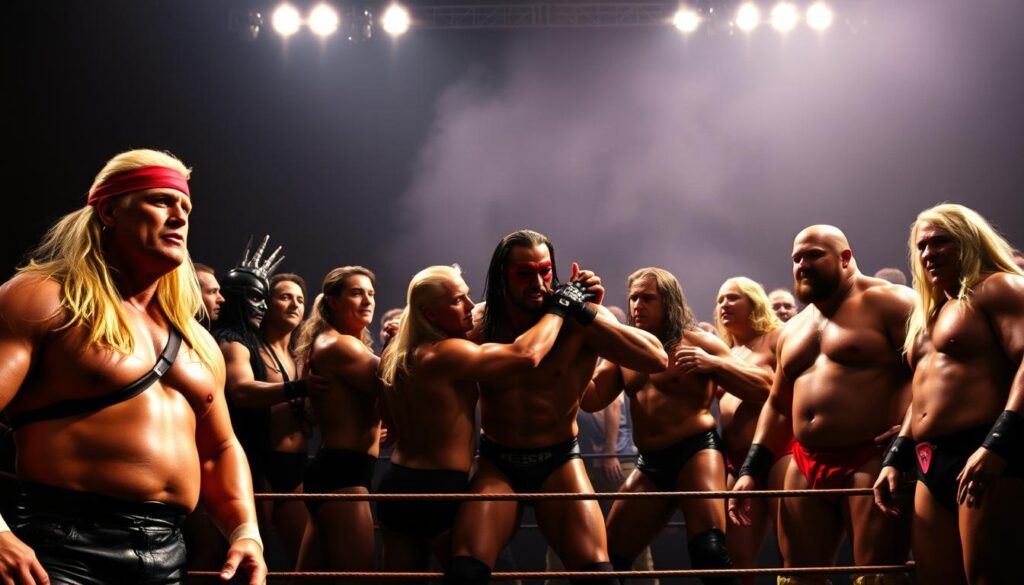Remember when flipping TV channels felt like choosing sides in a war? For 83 straight weeks, millions gripped remotes like commanders. USA Network’s gritty realism battled TNT’s neon rebellion. It was cultural trench warfare, fought with steel chairs and catchphrases.
The organization that dared challenge Vince McMahon’s empire became wrestling’s Icarus. It soared on black-and-white swagger and Hollywood heel turns. But, it plunged when backstage egos outgrew arena capacities. By 2001, its carcass fueled the very monopoly it sought to destroy – a cautionary tale with more twists than a ladder match.
Why does this matter beyond spilled popcorn and broken tables? The Monday Night Wars redefined storytelling physics. They showed audiences crave serialized drama, whether scripted or in Senate hearings. The nWo’s takeover mirrored America’s 90s obsession with antiheroes – think Tony Soprano in spandex, minus the therapy sessions.
We’ll explore how creative lightning got trapped in bureaucratic bottles. We’ll see why megastars became radioactive assets. And what Roman Empire collapse memes can teach us about corporate hubris. (Spoiler: Julius Caesar never took a Stone Cold Stunner.)
Brief History of WCW
WCW’s start is like Succession in pro wrestling, full of drama. It began as Jim Crockett Promotions, a regional powerhouse. Then, Ted Turner bought it, aiming to make wrestling more mainstream. The journey from Dusty Rhodes to Hulk Hogan was rocky.
From Crockett Promotions to Turner’s Titan
When Turner bought Crockett in 1988, it was a big change. Imagine Atlanta suits thinking “DDT” was banking jargon. The old-timers were too busy making great matches to worry about TV.
But WCW kept its rebellious spirit. Sting wore neon, Ric Flair wore fancy suits. They were more than wrestlers; they defied corporate rules. Turner’s team tried to tame wrestling, but it was hard.
The Nitro Revolution
Eric Bischoff, a former meatpacker, joined in 1993. His Monday Nitro in 1995 was bold. It was live, unpredictable, and full of surprises.
Nitro was known for its unpredictability. Lex Luger showed up out of nowhere. Madusa destroyed the Women’s Title in a trash can. It was like wrestling art.
The roster was full of stars:
- Hollywood Hogan’s new villain role
- Goldberg’s unbeaten streak (and its shocking end)
- Diamond Dallas Page’s charm winning over fans
By 1996, WCW was leading in ratings and changing wrestling. But, as ECW fans knew, this success wouldn’t last forever.
Its Role in Wrestling’s Golden Years
WCW was never about subtlety. It was pro wrestling turned into a high-end TV show. With soap opera betrayals and action sequences that would make Michael Bay blush, it was a wild ride. WWE focused on its cartoonish charm, but WCW made Monday nights unforgettable chaos.

The nWo: Wrestling’s First Viral Meme
Scott Hall’s 1996 invasion of World Championship Wrestling was more than a promo. It was the start of a cultural phenomenon. The nWo’s black-and-white look was like wrestling’s punk rock, with backstage politics rivaling House of Cards.
Kayfabe? Never Heard of Her
The real magic was in the meta-commentary. Hulk Hogan’s heel turn was like seeing Santa Claus rob a bank. The nWo’s 83-week ratings win showed fans loved messy reality over perfect scripts.
Gravity Was Just a Suggestion
The cruiserweights, like Rey Mysterio Jr., turned matches into Cirque du Soleil with folding chairs. Their moves, like the 450 splash, were like Picasso’s art. It was athleticism redefined.
The Global Takeover
WCW made international styles main events, not just curiosities. Juventud Guerrera and Psicosis didn’t need words – their hurricanranas spoke volumes. Suddenly, backyard wrestlers wanted to be human projectiles.
This wasn’t just WCW vs WWE – it was a cultural shift. Cruiserweights made athleticism cool, and the nWo made “fake” sports feel real. For 83 weeks, WCW led the ratings and made wrestling matter.
Key Factors in WCW’s Rise to Prominence
Imagine a world where a bold executive plays a game of chess while others play checkers. This is the story of the greatest power shift in wrestling history. It’s about how a small company became a huge underdog in pop culture.
Bischoff’s Maverick Playbook
Eric Bischoff didn’t just steal WWF’s stars. He turned them into something more. Hulk Hogan became Hollywood Hulk Hogan, a game-changer. This was like adding plutonium to the mix.
Bischoff’s plan wasn’t just about talent. It was about breaking rules. He made live shows that spoiled Raw results and promos that felt like Jerry Springer. It was a form of psychological warfare.
Monday Night Wars: When Wrestling Ruled TV
Do you remember when changing channels was a sport? The history of World Championship Wrestling changed with those Monday nights. Lex Luger’s arrival on TNT was like a mic drop before Twitter.
While WWF focused on cartoon morals, WCW brought drama and body slams. This led to a $55 million profit in 1998. It showed that adults would watch wrestling if treated as such. People wanted reality TV, but with more wrestling.
Factors Leading to WCW’s Decline
Imagine a giant, like The Simpsons after season nine, slowly losing its magic. That’s what happened to the wrestling empire that once challenged WWE. It fell apart due to bad decisions and poor management.
Veteran stars had too much power, like medieval lords. Younger wrestlers were treated like extras in a show for old folks. At the same time, executives didn’t know much about wrestling, treating it like a plaything.
Creative Car Crashes & Backstage Chaos
The 1999 Fingerpoke of Doom was a huge mistake. It was like Darth Vader saying he was with the Rebels during the Death Star’s final battle. WCW broke its fans’ trust. Stars like Chris Jericho were ignored, forced to do menial tasks.
Corporate Shifts: When Suits Killed Squashes
The 2000 AOL-Time Warner merger hurt WCW. Executives saw wrestling as a business, not a sport. They didn’t notice the $60 million losses until it was too late.
WCW’s Influence on Modern Wrestling
Twenty-three years after its last Nitro, Turner’s Atlanta promotion’s legacy lives on. Every body slam and betrayal echoes with WCW’s spirit. Scott Hall’s smirk and Sting’s crow paint are everywhere in today’s wrestling.
Let’s explore how a company that ended in 2001 continues to shape wrestling. It’s all about the steel chair shots and backstage power plays.
From Sting’s Crow to ‘Reality Era’
Do you remember Sting’s transformation in 1996? He went from a surfer to a dark, creepy character. This change didn’t just sell facepaint; it started a trend in wrestling.
Today, wrestlers like Bray Wyatt bring this same vibe to the ring. His Firefly Fun House is a modern take on Sting’s style. And don’t forget, today’s promos owe a lot to the nWo’s style.
Legends Never Die: WCW Alumni Today
Goldberg’s 2016 win over Brock Lesnar was like a flashback to 1998. DDP’s journey from a drunk tank regular to a yoga influencer is a testament to WCW’s magic.
Eddie Guerrero’s legacy and Chris Jericho’s reinventions have shaped wrestling. The cruiserweights who changed the cruiserweight division now influence wrestling worldwide. AEW’s roster feels like a WCW witness protection program, complete with benefits.
What Wrestling’s Greatest Flameout Teaches Us About Showbiz
WCW history is like a wrestling drama filled with big moves. The company’s fall showed the struggle between art and money, highlighted by Hulk Hogan’s huge salary. When wrestlers are paid like employees, their creativity fades fast, like a Disney tapings crowd.
WWE learned this hard way. They changed contracts to link pay to how well they perform.
The Bureaucratization of Mayhem
Guaranteed contracts turned WCW’s wrestlers into corporate types. They didn’t want to risk injury for new moves because they were paid no matter what. Today, wrestling is a mix of control and freedom.
WWE gives bonuses for good performances, and AEW lets talent be creative. This balance keeps wrestling exciting.
Villains Make the World Go ’Round
WCW’s story shows wrestling needs both good guys and bad guys. Eric Bischoff’s nWo was a hit because it mixed TV and comic book elements. But too much power can lead to problems, like in 2000.
Now, wrestling finds a middle ground. Paul Heyman’s SmackDown meets Vince McMahon’s business sense. Tony Khan’s AEW balances boldness with experience.
When Sting retired at AEW Revolution 2024, it was more than just nostalgia. It showed WCW’s spirit lives on in wrestling. The promotion may have died, but its legacy won the Monday Night Wars.

